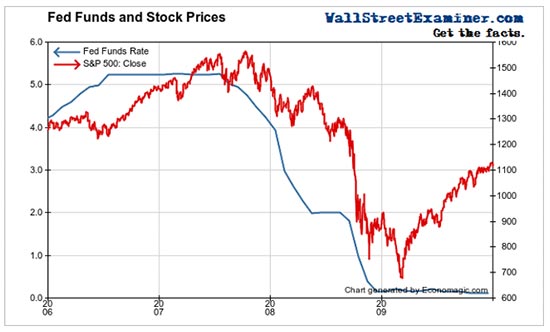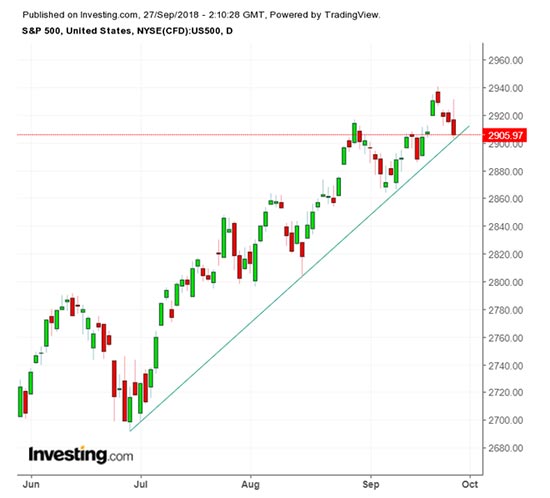A few days ago, Fed Chair Jerome Powell spelled out his view of the "Material Adverse Event" doctrine.
This was the idea put forth by Chair Yellen that the bloodletting of Fed balance sheet "normalization" would continue until morale got worse.
I first recognized the importance of this phrase in a piece I wrote singing Yellen's praises back in October of last year, just after the Fed made balance sheet bloodletting the official policy of the Fed.
I noted in the piece that Bernanke had left Yellen with the albatross of QE and a bloated Fed balance sheet that he thought would never be reduced back to normal levels.
That's because it ultimately would cause chaos in the financial markets to do so. Bernanke thought that permanent easy money would be his legacy.
But Yellen, to her eternal credit, chose to take those excess reserves out of the system and to begin returning the right to earn interest on their savings to the hard-working and thrifty savers who justly deserve it.
She also tried to hide the toughest part of the new policy, the fact that the Fed's systemic extinguishment of money in the banking system would be on autopilot.
Let's take a look at all this in a little more detail...
[mmpazkzone name="in-story" network="9794" site="307044" id="137008" type="4"]
The Fed Continues to Shrink Its Balance Sheet
The Fed even went so far as to announce last year, after the bloodletting policy became official, that it would no longer discuss it in FOMC statements. They wanted the market to forget about it. The stock market certainly has forgotten, but the money market and bond markets sure haven't.
The way the policy was structured tied the new Fed chair's hands. Or would have, except for the fact that Powell has repeatedly made clear that he agrees with it.
YOU KNOW IT IN YOUR GUT: Look at how things are going. Financial turmoil is coming just around the corner, maybe just a few months away. Click here...
I have reminded you in several previous reports that policy won't be reversed until that "material adverse event" actually occurs. That means that event is foreordained.
I took a stab at estimating when it might happen and was early, but the evidence is piling up that it will happen. Interest rates have been soaring in the Treasury bill and short-term note markets regardless of whether the FOMC meeting results in a Fed Funds rate increase or not.
I've opined in the past that a material adverse event would need to be at least a stock market crash, a bear market, and an economic recession. The policy Yellen laid out indicated that the first Fed move would then be to lower the Fed Funds rate.
But lowering rates would not matter as long as the Fed continued to shrink its balance sheet. By then, the damage to the markets would be tremendous. Rate cuts don't end bear markets.
Powell told us on Wednesday what he sees as a "material adverse event." He confirmed what I thought it meant. He said that it would require "a significant and lasting correction in markets - or a slowdown in the economy" to begin easing policy.
Even that's ambiguous regarding the economy. What's a slowdown in the economy? Simply slower growth? Not likely.
That certainly would not be sufficient to cause a reversal in balance sheet shrinkage, which is the real issue here. That shrinkage should end by May 2020 by my estimate because by that point reserves would be reduced to the point of being tight versus deposits.
That's the normal position of the Fed's balance sheet.
As a non-economist, it still seems patently obvious to me that the economy won't materially slow as long as the massive stimulus of trillion-dollar deficits continues. And it is certain that those deficits will continue.
The Problem Is a Superficially Strong Economy, Not Economic Weakness
No, economic weakness won't be the problem. If anything, a rip-roaring, deficit spending driven boom will only encourage the Fed to tighten even more and even faster.
So the economy will be a problem not because it weakens, but because it remains superficially strong. The Fed will continue draining reserves from the system. That's already causing massive upheaval in the money markets.
Bill rates are soaring. So are short-term note yields. The bear market in longer-term bonds will get worse as the Fed continues draining and the Treasury continues issuing gargantuan amounts of new supply month after month.
FEAR... PANIC... MISTAKES... RUIN: Investors likely don't have much time left before chaos strikes, and there's zero margin for error. Click here for details...
Two-year note yields are going stratospheric, and the pain has now reached the five-year notes, with the yields on those edging to a new high of 2.99 this week.
The 10-year is knocking at the door of a new high, reaching 3.10 before pulling back this week. When it goes through the May high of 3.12, thence comes the deluge!
Stocks, fueled by mania and speculative borrowing, have held out against this crush. But Yellen set it up so that the Fed will continue tightening the screws until the market succumbs to a "material adverse event."
And on Wednesday, Chair Powell told us that he's the tough hombre that will stick to tight policy until there's "a significant and lasting correction in the markets." That certainly means more than a measly 10% correction or even a fast 20% decline.
Earlier in the press conference, he alluded to the idea that a housing bust is a much more serious threat to the economy than a mere stock market decline. So it's pretty clear that there will be no Powell put for the stock market. Powell is warning you to be prepared to take some pain.
Furthermore, the Fed will only BEGIN to reverse policy AFTER a big market decline. The first steps toward ease never create a bottom. Stock prices continue to fall in early stages of lowering rates and priming the pumps.
Remember 2008? The Fed started lowering rates in 2007. The stock market didn't bottom until 2009. The S&P 500 lost 57% of its peak value while the Fed was lowering rates.

We've had enough warning. The market has been generous to those who hung on to their stocks despite the warnings. Those who stayed in have been rewarded again and again. Alarms have been sounding and the market has kept rising. That's how manias behave.
During Powell's press conference on Wednesday, the alarm sounded again. The late day sell-off in stocks was a recognition of that by some traders. It brought the market to this rally's trendline from the June low.

Closing below that line and below 2,900 would be a sign that this would be a good time to buy a few at-the-money puts on the SPY, expiring in about a month, to take advantage of the downside that's likely to follow.
These puts would give you tremendous leverage to profit from the downside, including the potential for triple-digit percentage gains. But remember to limit your trade to no more than you'd be willing to lose if we are too early again and the market extends its rally.
And if you're not already mostly out of stocks, let Powell's words serve as a reminder that the time is growing short to do so. If you choose not to sell, then at least use puts to cushion the portfolio losses that are sure to come.
"Trouble Is Brewing": According to Bloomberg's latest report, America could be heading for an economic disaster that would rival the Great Recession. Billionaire Ray Dalio's hedge fund - Bridgewater Associates - has made a $22 billion bet against the market. And Citibank calls our present situation "eerily reminiscent of the mortgage crisis." To see why we believe some of the richest players in the world are preparing for a market collapse, click here.
Follow Money Morning on Facebook, Twitter, and LinkedIn.
About the Author
Financial Analyst, 50-year charting expert, finance + real estate pro, and market analyst; published and edited the Wall Street Examiner since 2000.



